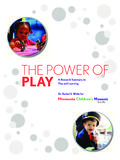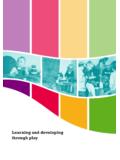Transcription of GAME-BASED LEARNING AND GAMIFICATION - …
1 GAME-BASED LEARNING . AND GAMIFICATION .. GUIDANCE FROM THE EXPERTS. W H I T E PA P E R | S E P T E M B E R 2 0 1 7. BY MICHELE ISRAEL. I N S Y N C 'S 1 4 E X P E R T S. Bryan Alexander, Educational Futurist, Bryan Alexander Consulting, LLC. Adam Coulson, Game Design Teacher, Highlands Ranch High School Karl Kapp, Instructional Design Professor, The notion might defy standard logic, but having fun Bloomsburg University; GAMIFICATION Analyst while LEARNING is a good thing. It's evidence- based : enjoyment heightens engagement and retention an Slawomir ais, Co-founder, LEARNING Battle Cards excellent reason to include gameplay in our blended Michael Mackay, Partner, Spongelab Interactive LEARNING campaigns. Nick Noel, Instructional Designer and Media Producer with Information Technology Services, GAMIFICATION and GAME-BASED LEARNING have become and the Hub for Innovation in LEARNING and primary teaching tools in digital LEARNING environments.
2 Technology, Michigan State University It's no wonder: they represent all that is motivating, from internal rewards, to teamwork and collegial support, to Andy Phelps, Founder/Director, Center for Media, Arts, games & Interaction and Creativity, Professor, the occasional tangible gift once mastery is achieved. School of Interactive games & Media, Rochester The combination of these benefits successfully builds Institute of Technology knowledge and skills that influence productivity. Ben Scragg, Instructional Designer, ODEE. Distance Education, Ohio State University Keep this top of mind when thinking about gameplay as an asset in your blended LEARNING event: people want Mike Skocko, Teacher, Director of The Mac Lab, to play a game that has educational substance; they are Valhalla High School not playing to win, but to learn and achieve. Earning Stephen T. Slota, , Instructional Design badges, for example, is exciting, but not the desired end Specialist and Game Design Specialist/Scientist, goal.
3 Learners thrive on intrinsic motivators, an internal University of Connecticut sense of achievement that comes from successfully Avi Spector, Education Consultant, solving a problem or completing a task. They want Riverside School Board real-world application and the positive results that come from that. Deborah Thomas, Founder and CEO, Silly Monkey International, LLC. GAME-BASED LEARNING and GAMIFICATION must be John Vivolo, Thought Leader in thoughtfully designed, drawing on the psychology of Educational Innovation and Technology, play and its usefulness as a LEARNING strategy. InSync rE- LEARNING Solutions, LLC. Training tapped into the expertise of fourteen experts Keegan Long-Wheeler, Educational Technologist for advice and guidance on GAME-BASED LEARNING and and Gamer, University of Oklahoma GAMIFICATION . GAME-BASED LEARNING and GAMIFICATION : Guidance from the Experts | September 2017.
4 2. DEFINING THE METHODS. There is a clear difference between GAME-BASED LEARNING and GAMIFICATION (both, however, are fun!). This distinction drives the . construct of gameplay in the LEARNING experience. ON GAME-BASED LEARNING . GAME-BASED LEARNING is the integration of actual PHELPS: GAME-BASED LEARNING involves games into the LEARNING process usually to teach a using game-like interactions, simulation specific skill or meet a specific objective. This method strategies, or structures to support gives learners the opportunity to become immersed in the pedagogical goals and outcomes. LEARNING process and to have fun while doing so.. GAMIFICATION , within the blended LEARNING context, is the concept of applying GAME-BASED approaches and LONG-WHEELER: When you use a game or game design as part of your instructional materials, you're engaged in GAME-BASED mechanics to non-game activities to promote learner LEARNING .
5 Common examples of this include participation and motivation. The goal of GAMIFICATION is using Minecraft to teach math, programming, to inspire learners to participate and interact with other geography, etc., or using sports to teach learners in an activity- or goal-oriented community. teamwork and other social skills. There are certainly more times we're LEARNING through Our contributing experts deepen these definitions. a game than for which we give credit. COULSON: It gamifies FUN LEARNING environments, allowing for self-paced LEARNING while creating intrinsic motivation through competition and choice. GAME-BASED LEARNING and GAMIFICATION : Guidance from the Experts | September 2017. 3. ON GAMIFICATION . KAPP: GAMIFICATION is using GAME-BASED mechanics, aesthetics, and game thinking to engage people, motivate action, promote LEARNING , and solve problems. In other words, it is the use of parts, elements, or techniques from games in the delivery of instruction.
6 GAMIFICATION should be about the use of the intrinsically motivating and deep elements of games , such as challenge, mystery, story, constructive feedback (meaningful consequences), strategy, socialization, and other elements that make games inherently engaging. SLOTA: GAMIFICATION is the application of Skinnerian behavioral principles to a particular LEARNING experience, often via a token economy. Player behaviors are encouraged with specific reinforcers ( , points, badges, scores, grades), contingent upon exhibiting a particular skill or completing a particular task. Such reinforcement is usually tracked on a leaderboard or some other display of relative standing compared to peers. Unlike GAME-BASED LEARNING , the goal of GAMIFICATION is to layer particular game mechanics (actions, processes, and control mechanisms used to gamify an activity) on top of an existing instructional activity or LEARNING environment, rather than designing a full, novel game experience intended for instructional purposes.
7 THOMAS: GAMIFICATION is the application of adding a gamified element layer to an existing LEARNING system or program. Game design elements can be added as an afterthought. Or the elements can be built in during the design of a new LEARNING implementation. These elements are designed to improve user engagement by using core compulsion events that make people want to participate in the gameplay. The participation should be designed not only to motivate the learner to play, but also to assist in the comprehension of the LEARNING event. ROLES IN THE SUPPORT OF LEARNING . Using games for teaching and LEARNING is not a new idea. There is much research supporting the power of play in skills and knowledge development. It is proven to strengthen memory, improve cognitive function, and encourage collaboration, all among a broad array of positive results. GAME-BASED LEARNING and GAMIFICATION : Guidance from the Experts | September 2017.
8 4. Dr. Diana Oblinger, president emeritus of Educause, captures the value of digital games for learners: Although definitions vary, digital games provide visual information to one or more players, accept input from the player(s), and use a set of programmed rules. Unlike traditional games , the rules are programmed into the code, not described in an instruction manual. The sensory interface and story add emotional appeal, as well. Digital games are complex, require collaboration with others, and involve developing values, insights, and new knowledge. They provide immersive virtual worlds, augmented by a complex external environment that involves communities of practice, buying and selling of game items, blogs, and developer communities. In many ways, games have become complex LEARNING systems. (Oblinger, 2006). GAME-BASED LEARNING and GAMIFICATION , while differently structured, share elements that propel LEARNING .
9 For example, they motivate, involve, and challenge users; ask participants to use prior knowledge to tackle incremental complexity; respond to learners' needs for intrinsic and extrinsic rewards; and hone competencies to use beyond the LEARNING environment.. With regard to GAME-BASED LEARNING 's role in blended LEARNING , our experts concur that it: Reminds participants of what they have learned and highlights their accomplishments . along the LEARNING journey;. Can make complex concepts easier to understand; and . Provides in-class activities that invite participants to practice and demonstrate the topics they have been LEARNING . Moreover, a well-designed and thoughtfully implemented GAME-BASED LEARNING asset incorporates layered strategies that engage learners in multi-faceted ways. SLOTA: GAME-BASED LEARNING for face-to-face, blended, and fully online LEARNING is rooted in the construction of playful environments where learners can interact with core content, then work with a more knowledgeable other to understand how and why core content transfers to real world thought and action (Vygotsky 1933/1976).
10 It largely has the same instructional role as GAMIFICATION : the two are useful instructional frameworks but not, in and of themselves, solutions to the wide-reaching challenges facing formal and informal education. Unlike GAMIFICATION , however, GAME-BASED LEARNING tends to grow out of more contemporary theories of thinking and LEARNING ( , social LEARNING , information processing, situated cognition), which makes instruction more efficient, increases engagement, and leads to external, user-generated content creation ( , group analysis and reflection).. GAME-BASED LEARNING and GAMIFICATION : Guidance from the Experts | September 2017. 5. KAPP: GAME-BASED LEARNING works best when it is delivered using a three-part method. The first is to inform the learners what they should focus on while playing the game, what general outcomes are expected, and/or what techniques they should use. This can be done online or in a classroom.






